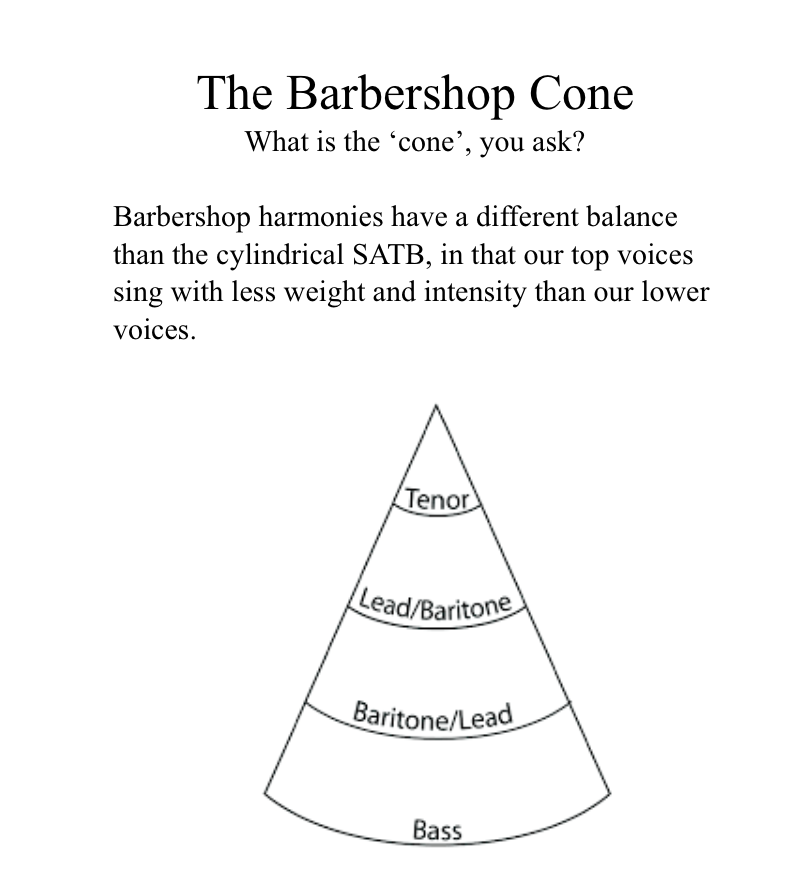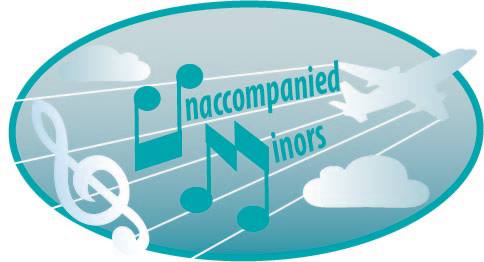What Makes Barbershop Unique?
Barbershop harmony is close, unaccompanied, four-part a cappella harmony. Although barbershop-style music is usually built on simple melodies and is relatively easy to sing, the a cappella style and the ear training necessary for independent part singing make it one of the most challenging and rewarding accomplishments of a vocal ensemble. When the music is sung accurately and with good breath support and vocal techniques, barbershop harmony produces overtone vibrations that create a resonant ring unique to this form of music. Of course you are familiar with SATB choral music, where the melody is usually in the First Soprano line, above all others. The voice parts in barbershop harmony have different names and functions than they do in SATB vocal styles.
The LEAD voice generally sings the melody and is below the TENOR harmony; the TENOR part sings the highest note in the chord; the BARITONE part fills in the all-important missing note in a chord that may be above and below the melody; and the BASS part supplies the harmonic foundation (root or fifth) of the chord. When these parts are sung properly and with minimal vibrato, the harmonics in the individually sung tones reinforce each other to produce audible overtones or undertones. Barbershoppers call this "ringing a chord."
There are other unique features to the barbershop style -- certain chord structures, singing within what is called the "barbershop cone" (singing each part to get the balance needed to produce harmonic overtones and undertones) vs. the more cylindrical, "stacked" sound of SATB music, etc. But the bottom line is, Barbershop music is incredibly flexible, definitely musical, and flat-out fun to sing! But don't take our word for why Barbershop is great music and great training for singers, come sing with us!
The LEAD voice generally sings the melody and is below the TENOR harmony; the TENOR part sings the highest note in the chord; the BARITONE part fills in the all-important missing note in a chord that may be above and below the melody; and the BASS part supplies the harmonic foundation (root or fifth) of the chord. When these parts are sung properly and with minimal vibrato, the harmonics in the individually sung tones reinforce each other to produce audible overtones or undertones. Barbershoppers call this "ringing a chord."
There are other unique features to the barbershop style -- certain chord structures, singing within what is called the "barbershop cone" (singing each part to get the balance needed to produce harmonic overtones and undertones) vs. the more cylindrical, "stacked" sound of SATB music, etc. But the bottom line is, Barbershop music is incredibly flexible, definitely musical, and flat-out fun to sing! But don't take our word for why Barbershop is great music and great training for singers, come sing with us!
The Parts
|
TENOR is a harmony part sung consistently above the lead. The tenor should have a light, sweet, pure tone that will complement but not overpower or overshadow the lead voice. Light lyric sopranos generally make good tenors. The range for tenor is from G above middle C to high G above the top line of the clef. Occasionally you will have notes below the lead. When this happens, your tonal quality will need to change from being light and clear to being more full and round. Flexibility is the key and knowing when you need to change.
LEAD is the melody and must be sung with authority, clarity and consistent quality throughout the lead's range. The lead sings with limited vibrato to add color and warmth to the sound. With too much use of vibrato, the chord will not “lock” or “ring” or produce the unique, full and “expanded” sound that is characteristic of barbershop harmony. The lead is responsible for conveying the interpretation, emotion and inflections of the song. The range is equivalent to a Soprano II and is from A below middle C, and C above middle C. On the rarer occasions when the melody line is in another part, which may be only for a few notes, the lead will need to be aware to lighten her vocal quality to allow the melody to shine wherever it is being sung. If you are in a quartet, the others will follow your lead. In a chorus, we all follow the director.
BARITONE covers approximately the same range as lead. The voice part is similar to the equivalent of an Alto I except that baritone harmony notes cross the lead notes. Primarily sung below the lead but sometimes sung above, depending on where the melody is situated, baritones must constantly adjust their balance to accommodate their position in the chord. They must have a good ear.
BASS is the lowest note in the barbershop chord. Singers should have a rich, mellow voice and generally sing the root and fifth of each chord. The bass sings a relatively straight, well-produced tone with a minimum of vibrato. The range is comparable to that of a contralto or Alto II in traditional choral music. The range is from E-flat below middle C to G above middle C. Similar to the baritone, this part is written in the bass clef an octave lower than it is actually sung. A bass sings with a heavier tone quality than the others and generally with more volume, to fill out the “cone.” The bass part provides the foundation of each chord.
|

